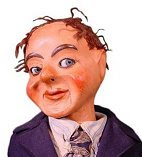I'm not going to do a full review of Stott's book here, there are plenty online if you wish, but I will agree with all those that I have read and say that the style in which it has been written is far more than a biography, it is more like a 'journey' through the theatrical scene of London at the turn of the 19th Century. Stott has the enviable ability to write in such a way that you get all the facts and dates required for a biography, but at the same time he is able to paint a picture of the theatre scene that makes you wish you were there to actually see it, while at the same time thanking god that you weren't! He describes in detail the characters of the day visually depicting them, warts and all (in many cases literally!) and in doing so creates his own performance where you begin rooting for 'Joey' and wanting to 'boo and hiss' the less than trustworthy managers and owners of the most popular theatres of the day; Sadlers, Drury Lane and Covent Garden. Every so often Stott digresses slightly to tell another tale of London life and gives us in insight and mental picture that is so vivid you could, with little imagination, imagine you were there.
Joseph Grimaldi himself is quite a pitiful character at times, despite being the saviour of many London theatres (he regularly drew huge audiences) and to that degree doing quite well for himself, he was plagued by misfortune and injuries following the demands he would put on his body each night and a string of personal tragedies - his Italian father (also a clown) severely beat him and his brother, his first wife died in childbirth (along with his first child) his second child died in suspicious circumstances at the age of 30, following this he and his second wife draw up an unsuccessful suicide pact. Stott heavily relies on this melancholy personal life as the muse for his success as a clown, he theorises that he created the 'Sad comedian', a theme that has continued with current comedians; the idea that humour is derived through the battle with their own demons.
Joseph Grimaldi reinvented the clown, he was the first to use white-face make up and wear outrageous over sized and colourful clothes He was the first in a new culture of celebrityism that, until his day, had been reserved for only the Royals and the honoured few, An example of this is that his memoirs were published and edited by "Boz", a young Charles Dickens. Grimaldi is still remembered each year with a Church service in London attended by many clowns of the day.
Stott illustrates his life vividly and gives us a true insight into everything that was happening at the time, his ability to picture and then put into words the atmosphere of London is a credit to both his imagination and style of writing and the meticulous research he has clearly undertaken.
As someone who is fascinated with circus and the theatre of the 18th and 19th century I would quite clearly recommend this book, but I would recommend it not just to those with an interest in these areas but anyone wishing to gain an insight into the culture of London and the life of some colourful characters who lived there.
RIP Joseph Grimaldi (18 Dec 1778 - 31 May 1837)







No comments:
Post a Comment